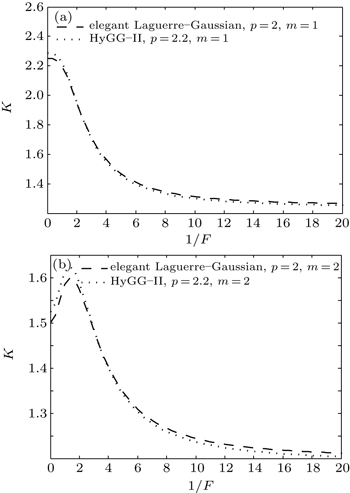† Corresponding author. E-mail:
Based on the irradiance moment definition and the analytical expression of waveform propagation for hypergeometric-Gaussian type-II beams passing through an ABCD system, the kurtosis parameter is derived analytically and illustrated numerically. The kurtosis parameters of the Gaussian beam, modified Bessel modulated Gaussian beam with quadrature radial and elegant Laguerre–Gaussian beams are obtained by treating them as special cases of the present treatment. The obtained results show that the kurtosis parameter depends on the change of the beam order m and the hollowness parameter p, such as its decrease with increasing m and increase with increasing p.
Much effort has been conducted recently to describe the characteristics of different laser beams, like the M2-factor, power fraction ‘PIB’, kurtosis factors, etc. As is well known, the beam propagation factor is a useful parameter for describing laser beam quality[1] which is based on the second-order moment, while the fourth and second-order intensity moments have been used to define the so-called kurtosis parameter K, which is a measure of symmetry and sharpness (or degree of flatness) for the intensity distribution of a laser beam.[2] The intensity profile of any laser beam is classified as leptokurtic, mesokurtic or platykurtic distributions according to the kurtosis value K being higher, equal or less than 3, which is the kurtosis value of the fundamental Gaussian beam for the one-dimensional case.[3]
On the other hand, the kurtosis parameters of various laser beams, except a few types, Gaussian and Hermite-Gaussian beams, change their magnitudes during the beam propagation through an unapertured paraxial optical ABCD system.[4] Many studies have been provided about the kurtosis parameter characteristics of different laser beams, such as flattened Gaussian beams, Bessel-modulated Gaussian beams, elegant Hermite–Gaussian, elegant Cartesian Laguerre–Hermite–Gaussian and Laguerre–Gaussian beams, Hermite–cosh–Gaussian beams, etc., propagating through ABCD optical systems.[4–13]
The aim of the present work is to study the propagation of the kurtosis parameter of a hypergeometric-Gaussian type-II (HyGG-II) beam. The rest of this paper is organized as follows: in Section 2, we give the theory of the propagating HyGG-II beams in a paraxial optical ABCD system, and in Section 3, we present the theoretical expressions of the kurtosis parameters of the considered beam family. In order to illustrate the obtained results, we present some numerical simulations and discussions in Section 4. Finally, we draw some conclusions in Section 5.
In a polar coordinate system (r0, θ0), the electric field distribution of a HyGG-II beam at the plane z = 0 is described as[14]



Figure
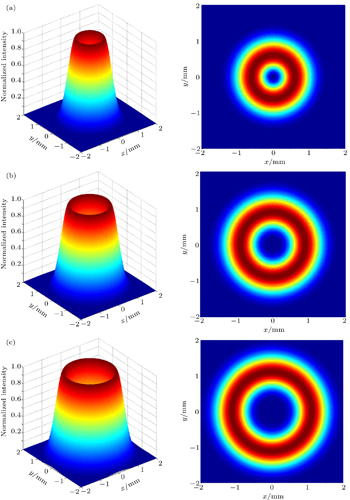 | Fig. 1. Normalized intensity distributions of HyGG-II beam in the 3D direction at the z = 0 plane, ω0 = 1 mm and p = 1.2 for m = 1 (a), 2 (b), and 3 (c). |
The propagation of a general beam through an optical paraxial ABCD system is described by Huygens’s integral in the Kirchhoff–Fresnel approximation



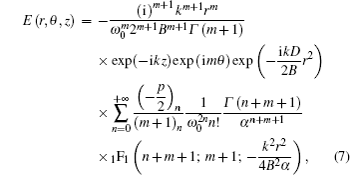

The kurtosis parameter of rotationally symmetric laser beams in the cylindrical coordinate system can be defined as[4,11]









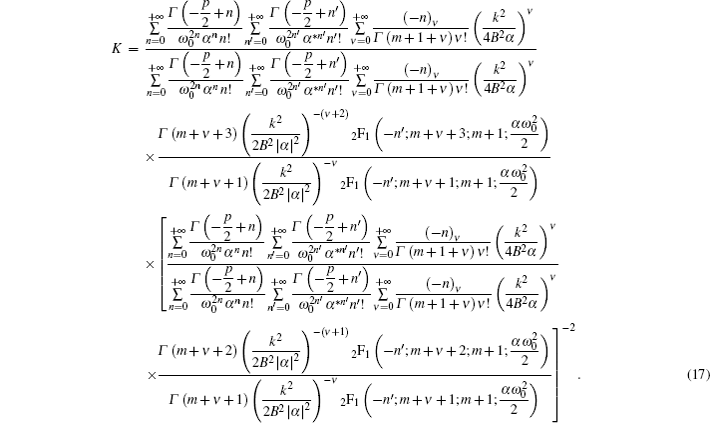
Three interesting special cases of Eq. (
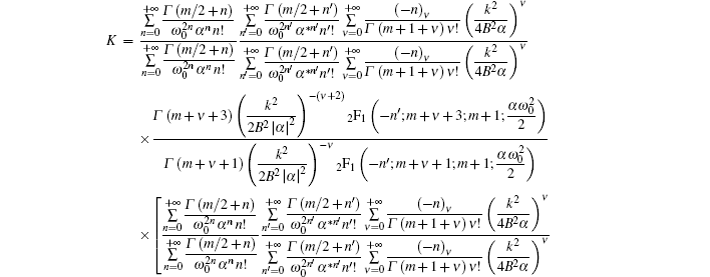

In this section, the matrix elements are chosen to be A = 1, B = z, C = 0, and D = 1. The other parameters are λ = 0.6328 μm, ω = 2 mm, and the Rayleigh range 

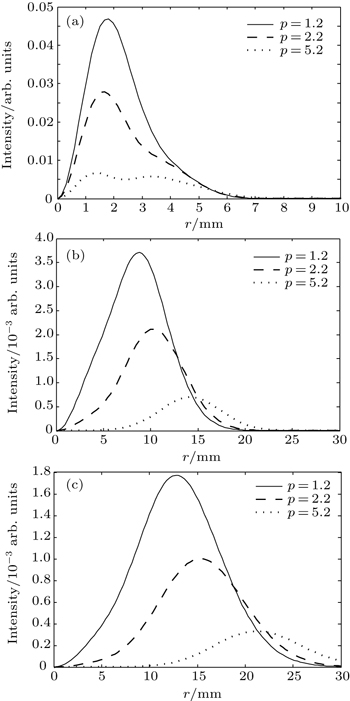 | Fig. 2. Intensity distributions of the HyGG-II beam each as a function of r with λ = 0.6328 μm, m = 1, ω0 = 2 mm for z = zR (a), 4zR (b), and 6zR (c). |
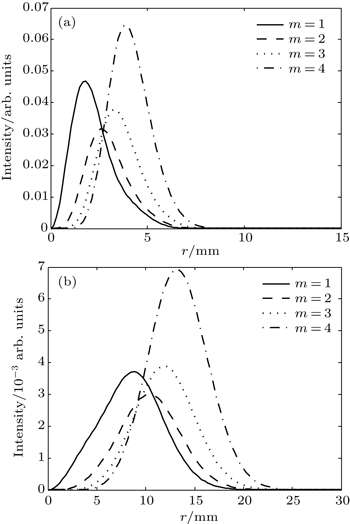 | Fig. 3. Intensity distributions of the HyGG-II beam each as a function of r with λ = 0.6328 μm, p = 1.2, ω0 = 2 mm for z = zR (a) and 4zR (b). |
From Fig.
Figure
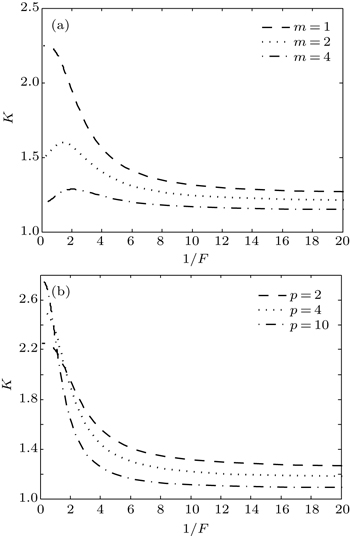 | Fig. 4. Variations of kurtosis parameter K of an elegant Laguerre–Gaussian beam with Fresnel number F in the cases of p = 2 (a) and m = 1 (b). |
The dependence of the kurtosis parameter K of an MQBG beam on generalized Fresnel number F are illustrated in Fig.
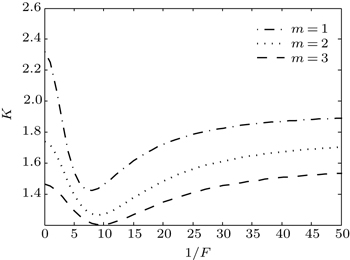 | Fig. 5. Variations of kurtosis parameter K of a MQBG beam with Fresnel number F for three different values of m. |
It can be seen from Fig. Variations of kurtosis parameter K of a HyGG-II beam with Fresnel number F in the cases: m = 1 (a) and 2 (b) for different p values; and p = 1.2 (c) for different m values.
Finally, by using our main result in Eq. (
From the previous figures, we can conclude that the values of the kurtosis factor of the HyGG-II beam and their subfamilies are always smaller than 3. Therefore, we can say that the HyGG-II beams are classified within the leptokurtic distribution.
In this paper, based on the propagation equation of the HyGG-II beam propagating through a paraxial ABCD optical system, the analytical expression for the kurtosis parameter of the HyGG-II beam is derived. The obtained results show that the kurtosis parameter of the HyGG-II beam changes with beam order m, and hollow parameter p. In addition, the K parameter of the fundamental Gaussian beam, the kurtosis of the superposition of two modified-Bessel beams and the kurtosis of the elegant Laguerre–Gaussian beam are obtained analytically as special cases and illustrated numerically.
| 1 | |
| 2 | |
| 3 | |
| 4 | |
| 5 | |
| 6 | |
| 7 | |
| 8 | |
| 9 | |
| 10 | |
| 11 | |
| 12 | |
| 13 | |
| 14 | |
| 15 | |
| 16 | |
| 17 |



